Mihail Marin: English 1. c4 e5 (A20-A29)
An example for an database text: "A29 4...Bb4 5.Bg2 - deviations"
You may write about the review to our discussion board
Mihail Marin: English 1. c4 e5 (A20-A29) An example for an database text: "A29 4...Bb4 5.Bg2 - deviations" You may write about the review to our discussion board |
One preliminary note: In the original database text, there are lots of links to the mentioned games and opening keys which are not represented here.
7.Ng5
6...Bxc3
Time has come to examine earlier deviations from the main line. The most
important of them is 9…b6, with an already known idea. After 10.Ne3
Bb7,
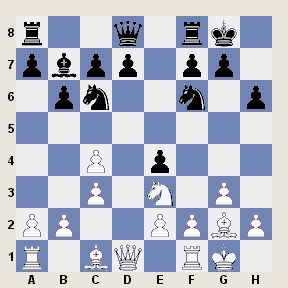
the somehow stereotype 11.Qc2 seems to create Black no problems, he can already transfer his Knight to the King side, with 11…Ne5 or, even better, 11…Ne7 , see for instance the already mentioned game Pogorzelski,W - Korolev,S 0-1.
11.f4 exf3 12.exf3 does also play into Black's cards, since he already controls the long diagonal and has practically annihilated Bg2. See Uhlmann,W - Farago,I ½-½.
The most logical move is 11.Nd5 , restricting the black Bishop. Besides, White has not to fear Bf5 any more, as in the 10…d6 lines. Black continues 11…Ne5 (11…Ne7 is bad in view of Nxf6) and White should rely on the stability of his position by playing 12.b3 rather than 12.Bf4 , after which the correct way to equalize is shown in the notes to Uhlmann,W - Gipslis,A ½-½. After 12.b3 Re8 , the current opinion of theory is that 13.a4 is the best move for White, eventually threatening a4-a5 and preparing the development of the Rook on the second rank. The only problem is, as usual, that, even if White will manage to realize all his ideas (f4, exf3, cxd5) Black will enjoy certain stability on the Queen side (Imagine a black Knight on c5). The direct 13.f4 is not too popular and is given a "?!" by Makarychev in his notes in Chess Informant. I think, however, that it is not worse than the approved 13.a4. See the notes to Uhlmann,W - Makarichev,S ½-½ and Portisch,L - Farago,I 1-0.
A similar deviation from the main line is 10…b6 .
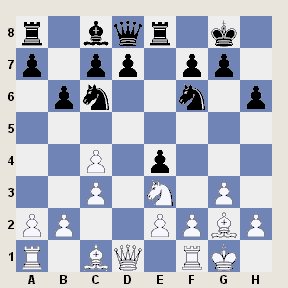
It has little independent value. After 11.Nd5 Bb7 12.b3, play transposes to the previous paragraph. You might have guessed that 11.Qc2 Bb7 12.f4 promises little, for similar reasons as before, see Huebner,R - Smyslov,V ½-½.
Why does Black need 8…h6 at all? The answer, after 8…Re8 9.Nc2 d6 is given by the move 10.Bg5 , for instance 10...h6 11.Bxf6 Qxf6 12.Ne3 , which weakens in a chronic way Pe4. See for instance the game Uhlmann,W - Reshevsky,S 1-0.
Less clear are the things after 9…Ne5 10.b3 (10.Ne3 would close the diagonal c1-h6 and the threat Bg5 would have ceased to exist at all.) 10…d6 . From the practical examples available, I couldn't find any possible way to fight for an advantage with White. The trick lies in the move order; White should play Bg5 first (on the 9-th move) as was the case in the mentioned game. But isn't in this case the exchange on c3 premature?
After 7…Re8 , White has at his disposal the strong 8.Nd5 (the difference is that on e1, as strange as it might seem, the Knight is better placed than on h4, as in the 5.Nd5 lines) see Portisch,L - Huebner,R 1-0 (this game is actually classified under 6...Re8 7.Nd5 e4 8.Ne1 ) and Uhlmann,W - Meduna,E 1-0. Less convincing is 8.Nc2 Bxc3 9.dxc3 and now, in view of the previous paragraph, 9…Ne5 is strong.
With the Knight on e1, 8.bxc3 does not seem very logical, since it will be difficult for White to make pressure on e4. I found, however, an interesting game between strong players, which might give some ideas about the whole thing, Neverov,V - Groszpeter,A 1-0.
A more modern tabyia, reactualized by Kasparov in his world title match against Karpov, Sevilla 1987, arises after the moves 7.Ng5 Bxc3 8.bxc3 Re8 9.f3.
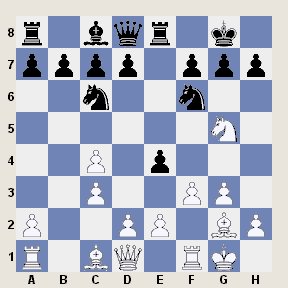
White's idea is clear: exchange the only black central Pawn and put his own central mass into motion, helped also by the powerful Bishops. The line was considered as inoffensive, since after 9…exf3 10.Nxf3 d5 11.cxd5 Black can play 11…Qxd5 , not fearing a discovered attack and intending to move to h5, in order to put a strong pressure on the white King side. White will find it not easy to advance his central Pawns.
In the first game where he was confronted with this line, Karpov deviated, however, as early as the ninth move, by offering a very interesting Pawn sacrifice, 9…e3, which came as a total surprise for his rival. He went on winning the game and this was the birth of one of the youngest variation of the English Opening… After an unusual long thought, Kasparov declined the sacrifice with 10.d3 d5 11.Qb3 but, in spite of his efforts to liven up the game, the far advanced Pawn clearly hindered White's actions. Even if this Pawn looks vulnerable, the small material advantage can prove not worth the efforts and concessions made by White to win it Kasparov,G - Karpov,A 0-1.
I red with mixed feelings Dolmatov's statement in the book Secrets of Opening Preparation. He claims that 11.Qb3 practically refutes Black's adventure and, in order to be more convincing, he mentions that he had been one of Kasparov's seconds during the respective match. It might be that the secrets of such complicated lines are too deep for us, mortals, but checking the database, one can see that very few strong players have in the meanwhile opted for this line as White. Lautier,J - Illescas Cordoba,M 0-1 followed a recommendation by Karpov (ending with an +\=) but… White lost practically by force!
White deviated with 11.cxd5 Nxd5 12.Qb3 in Gulko,B - Ivanchuk,V ½-½, but after a sharp play a draw was reached.
10.d4 is another tested move, but weakening the c4 square can't really offer White prospects for an advantage, see for instance Olafsson,H - Naumkin,I 0-1.
What makes Dolmatov's statement even more curious is that Kasparov himself, in later games, opted for 10.dxe3 ,
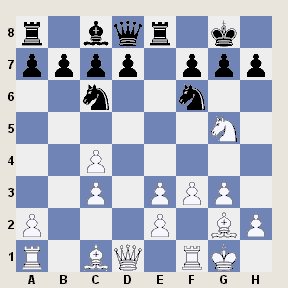
obviously a critical line. (One possible explanation is that his opponents were not of his own caliber and he chose a "second rate" move, saving the main line of his analysis for a better occasion). White doesn't really hope to keep his extra Pawn, since Pc4 is desperately weak, but he hopes to keep a good control in the center and on the King side and put his pair of Bishops in action. Black's position is, however, quite solid and too direct operations can lead to disaster for White, see for instance Topalov,V - Gelfand,B 0-1. After studying most of the games played, I discovered that White's main plan is to bring the Knight to f4 and then drive away Nf6 by means of g4, (if necessary h4) and g5, in order to take control of the d5 square and to win more space. See the notes to Kasparov,G - Rao,V 1-0 and Kasparov,G - Sadvakasov,D ½-½. I have noticed that in more than one games between strong players (Psakhis,L - Avrukh,B ½-½, Gulko,B - Illescas Cordoba,M 1-0) White played Nh3-f4-d5 with the black Knight still on f6. It is easy to note that after the exchange of Knights White falls far behind in the development, which tends to be more important than the improvement in the pawn structure; applying one of Tarrasch' methods of evaluating the position, what sense does it make to exchange a Knight that has consumed 5 tempi on one that had moved just once?… As usual in hipercomplicated positions, the final result doesn't reflect too well the outcome of the opening. It is, of course, difficult to pretend giving any final conclusions on a variation only 15 years old. In the computer era, when people tend to switch to ALT+F2 rather than looking at the position, progress of theory is sinuous and slow.
Following his win from the second game of the match, Karpov later deviated with 9..exf3 10.Nxf3 Qe7 , still avoiding the approved main line. The position after 11.e3 d6 was considered to be in White's favor, since Black has little to show for White's increasing pressure on the f file and in the center, see for instance Smyslov,V - Peev,P 1-0. (later, Adams showed a better way to resist with Black in this structure, at least in a rapid game, Ivanchuk,V - Adams,M ½-½, but the general assessment remains the same). Karpov produced the novelty 11…Ne5, but the experiment was far from a success; Kasparov managed to find over the board a very efficient continuation, Kasparov,G - Karpov,A 1-0.
It was only after the match that the secret regarding Kasparov's preparation against 10…d5 was revealed: instead of 11.cxd4 (which only helps Black to develop) he played the stronger 11.d4 and won a beautiful game against one of his most difficult opponents. (Kasparov,G - Ivanchuk,V 1-0). The game showed that, in spite of the apparent weakness of the e4 square, Black cannot consolidate in the center, while White's pressure along the diagonal h1-a8 and the open lines b and f is very strong. Since then there have been no major changes in the assessment of the position: White has a strong initiative. Chernin,A - Farago,I 1-0 and Smirin,I - Avrukh,B 1-0 are just 2 more examples at grandmaster level.
As a conclusion, Karpov's 9…e3 is critical for the evaluation of the whole line. Time has come to examine the early deviations.
The position arising after 9.d3 (instead of 9.f3) will be examined from another move order: 6....Bxc3 7.bxc3 Re8 8.d3 e4 9.Ng5.
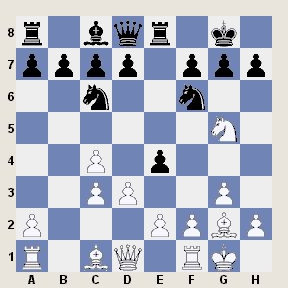
White can also try to attack the center with d2-d3 after the intermediate 9.Qc2 Qe7 . By doing this, he forces the black Queen to occupy a slightly exposed position, but White's Queen is also not on a very favorable square. After 10.d3 exd3 11.exd3 the approved continuation is 11…b6 preparing 12…Bb7 and Na5. (11…d6 is considered dubious in view of 12.Rb1, making further development of the black Queen side difficult; in some correspondence games, however, Black did fine after 12…Qe2.) Black's position is very solid, but practice has demonstrated that, in case of careless play, he can face circumstantial problems, as in the games Gheorghiu,F - Bisguier,A 1-0 and Kholmov,R - Kapengut,A 1-0.
In the main line, Black can defend his central Pawn not only with the Rook, but also with 8…Qe7 . This move makes sense from the perspective of the line 9.f3 e3!? and the Queen is closer to the c5 square. White can, however, change plans and take advantage of the early exposure of the Queen with 9.d3, see Yakovich,Y - Olausson,C 1-0 and Christiansen,L - Jussupow,A 1-0.
While 8.bxc3 is associated with 7.Ng5 (just as 7.Ne1 is automatically followed by 8.dxc3), such players like Adorjan and Murey have advocated in their games the less popular 7.Ng5 Bxc3 8.dxc3 followed by 8…Re8 9.Qc2 Qe7 10.Nh3 .
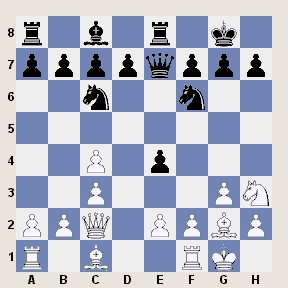
The idea behind this apparently illogical capture is to transfer the Knight to d5 (via h3-f4) with similar ideas with those guiding the 7.Ne1 line. On its way to d5, the Knight will have a less stable position on f4 than on e3, stopping, at the same time, the typical f2-f4. This means that in some case the Knight might have to jump to d5 earlier than desirable. As a compensation, the perfect e3 square is left vacant for the Bishop. Black is best advised to take the d5 square under severe control whenever the Knight reaches the f4 square (Qe5, Ne7). The necessity of preventing Bg5 is questionable, (see Adorjan,A - Olafsson,H ½-½; in Murey,J - Dankert,P 1-0 White didn't even try to make use of the omission of h7-h6) but 10…h6 is still the most popular continuation. The general feeling is that Black is safe here. Adorjan didn't manage to win a single game, although against Hjartarsson he had a spectacular fight Adorjan,A - Hjartarson,J ½-½. An interesting plan for White was seen in Murey,J - Wittmann,W 1-0. In fact, Murey was by far more succesful than the Hungarian GM and for those looking for inspiration from White's point of view, I recommend studying also Murey,J - Birnboim,N 1-0. A very sharp alternative to 10…h6, namely 10…Qc5, was seen in Chekhov,V - Dvoirys,S ½-½. The whole line needs (and, in my opinion, is worth) more games, in order to get a "final" conclusion.
We have seen that after 7…e4 Black has reasonable chances. On the other hand, by exposing at such an early stage his central Pawn, he leaves White with a certain strategic initiative. Black has also tried other, less committal moves. The most important are Re8 and d6, with or without a previous Bxc3. Delaying Bxc3 can transpose to 7…Bxc3, but White gets the additional possibility of jumping with the Knight to d5.
After 6…Re8 7.Nd5 (on 7.d3 Black should transpose with 7…Bxc3 to the line 6…Bxc3 7.bxc3 Re8 8.d3, since with every move that passes, the effects of the Knight jump to d5 would be stronger) we get a slightly altered form of the 5.Nd5 variation. (it would be a good idea to study the 2 variations together in order to get a better picture about them).
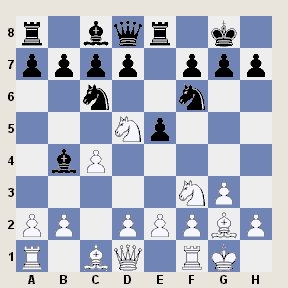
Black has already spent a tempo with Re8, which usually makes sense in combination with e5-e4. However, after 8…e4 9.Ne1 , the white Knight is better placed than on h4. On the edge of the board, the usefulness of the Knight can prove to be a circumstantial thing, while on e1 it has the perspective of d2-d3, exd3, Nxd3, with a strong central position for White. Smyslov,V - Mestel,A 1-0 is a good example.
The position after 8…Bc5 can effectively arise from the 5.Nd5 line, where Black would play 8…Re8 instead of 8…d6. After 9.d3 Nxd5 (9…h6 10.e3!? like in the 5.Nd5 line) 10.cxd5 Nd4 11.Nd2 d6 12.e3 Nf5 13.Nc4 Black showed an interesting way to play on both wings in Serper,G - Kortschnoj,V 0-1. Although never played, 11.Nxd4 deserves consideration, similarly to the 5.Nd5 line. 8…Bf8 is a safe, though somewhat passive way to solve the problem of the Bishop. After 9.d3 h6 White should prepare the development of the Bishop on the other long diagonal, either with 10.Bd2 (Stein,L - Barcza,G 1-0 and Polugaevsky,L - Podgaets,M 1-0, the second one demonstrating an interesting plan for Black) or 10.b3 (Rubinstein,A - Duras,O 1-0 and Gulko,B - Ivanov,A ½-½; some readers will note a strong similarity between the first one and Stein-Barcza; it is really hard to find something completely new!).
Finally, Black can play 8…Nxd5 9.exd5 Nd4 . After the typical 10.Ne1 Black can make use of the fact that his d-Pawn is still on its initial position and play 10…c6 with a complicated play. White is better advised to play 10.Nxd4 exd4 11.e3 (11.e4 could transpose after 11…dxe3, but gives Black more liberty of choice, while 11.b3 would follow the same idea, of breaking with e4-e3). See Timman,J - Huebner,R 1-0 and Ribli,Z - Andersson,U ½-½.
The direct 6…d6 allows White to transpose to a genuine position from the 5.Nd5 line, but 7.d3 is also possible. Like in the previous paragraph, Black is best advised not to try White's patience and take on c3 while still possible. For instance, 7…h6 (preparing Be6) would be strongly met by 8.Na4 (Gulko,B - Short,N 0-1 and Lautier,J - Hertneck,G 1-0).
Finally, we reach the lines involving an early exchange on c3. After 6...Bxc3 7.bxc3 (White strengthens his center; with the black Pawn still on e5, it makes less sense to play 7.dxc3, since the dark squares are not weak). Black has once again a choice between 7…Re8 and 7…d6.
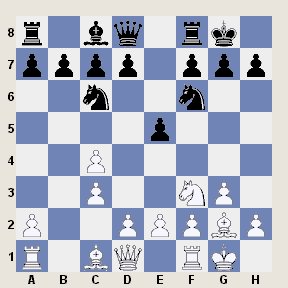
After 7…Re8 , the best move is 8.d3 . White has to start the fight for the center as soon as possible and to complete the development. Delaying d2-d3 could leave Black with a firm control of the center, because of the absence of Nc3 and the problems with developing Bc1. Black should also not lose time; 8…e4 is the logical way to put Re8 into action. After the "neutral" 8…d6 , White could get a firm grip on the center with 9.e4, leaving Re8 a bit misplaced. See for instance Botvinnik,M - Langeweg,K 1-0. After 8…e4, White has a choice between 9.Nd4 and the less fashionable 9.Ng5.
In case of 9.Nd4 , the typical structure of the whole line is reached after 9…exd3 10.exd3 Nxd4 11.cxd4 h6 12.Rb1 d5 13.Bf4 which is explained in the notes to Karpov,A - Anand,V 0-1. (In Hodgson,J - Salov,V 0-1, Black chose a slightly dubious setup, involving b6 and Bb7). Depending on the concrete move order, several deviations are, however, possible.
For instance, Seirawan,Y - Gulko,B ½-½ saw 12.d5!?, which, in spite of the resulting draw might be a good try for an advantage. Black can try to delay the exchange on d4, (9…exd3 10.exd3 h6 ) but then 11.Be3 is possible, intending to take on d4 with the Bishop. White wasn't very successful in Gurevich,M - Salov,V ½-½, but the idea deserves further investigation.
The immediate 9…h6 brought success to Karpov against Kasparov in the Sevilla match Kasparov,G - Karpov,A 0-1, but later, Portisch (who was present in Sevilla as a second) improved on White's play in his game against Salov Portisch,L - Salov,V ½-½.
Finally, a very natural question (familiar to the reader from other lines) is whether h7-h6 is really necessary at such an early stage. After 9…exd3 10.exd3 Nxd4 11.cxd4 d5 12.Bg5 White's results are good, but not necessarily because of the opening; see the notes to Gulko,B - Huebner,R 1-0, Gray,W - Thompson,P ½-½ and Van Dalfsen,P - Magnusson,G 1-0. White could, of course, refrain from Bg5 and, most probably, the structure would be similar to the already mentioned Karpov,A - Anand,V 0-1, where Black might have to play h7-h6 anyway at some moment. Still, this would be a small success for Black, since all the deviations previously mentioned would have been avoided.
One more way to refrain from h7-h6 is 9…Ne5 as played for the first time at high level in Serper,G - Lobron,E ½-½. Maybe White's play in Razuvaev,Y - Sedina,E 1-0 is an improvement.
The position after 9.Ng5 can also arise from the 7…e4 8.Ng5 line. The characteristics are similar to those arising from the line where Qc2 and Qe7 were included: Black should be able to maintain the balance with a few careful moves. The safest continuation look to be (after 9…exd3 10.exd3) 10…h6 11.Ne4 b6 , driving the Knight away from its threatening position and preparing to neutralize the white fianchetto Bishop. See Taimanov,M - Bronstein,D 0-1, Romanishin,O - Taimanov,M 0-1 and Huebner,R - Kasimdzhanov,R 0-1. The direct 10…b6 allows unnecessary complications after 11.Bd5 (Christiansen,L - Kaidanov,G 1-0) while 10…d6 11.Rb1 h6 12.Ne4 led to a dangerous white initiative in Mecking,H - Tan Lian Ann 1-0.
Although after the exchange on c3, the move 7…d6 introduces some differences compared to the 7…Re8 line, the general picture is similar. Play continues 8.d3 e4 9.Nd4 and Black has to take on d3, since the e4 square is less protected than in the 7…Re8 line. After 9…exd3 White gets nothing special with 10.Nxc6 (Mecking,H - Kortschnoj,V ½-½ and Von Rein,G - Hobusch,W ½-½). Better is 10.exd3 Nxd4 (for 10…Ne5 see Urday Caceres,H - Slobodjan,R 0-1) 11.cxd4 with certain pressure against the Queen side, which practically forces Black to lose a clear tempo in order to get the structure from Karpov,A - Anand,V 0-1